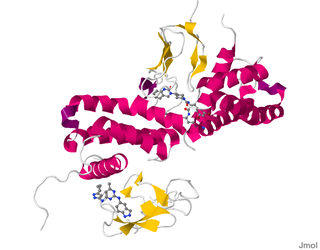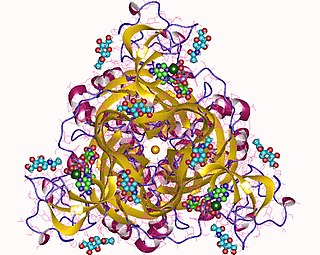
H2 receptors are positively coupled to adenylate cyclase via Gs alpha subunit. It is a potent stimulant of cAMP production, which leads to activation of protein kinase A. PKA functions to phosphorylate certain proteins, affecting their activity. The drug betazole is an example of a histamine H2 receptor agonist.
A kinin is any of various structurally related polypeptides, such as bradykinin and kallidin. They are members of the autacoid family. Kinins are peptides that are cleaved from kininogens by the process of kallikreins. Kallikreins activate kinins when stimulated.

Adrenomedullin is a vasodilator peptide hormone of uncertain significance in human health and disease. It was initially isolated in 1993 from a pheochromocytoma, a tumor of the adrenal medulla: hence the name.

Motilin receptor is a G protein-coupled receptor that binds motilin. It was first cloned in 1999 by Merck Laboratories. and scientists have since been searching for compounds to modify its behavior.
Prostaglandin receptors or prostanoid receptors represent a sub-class of cell surface membrane receptors that are regarded as the primary receptors for one or more of the classical, naturally occurring prostanoids viz., prostaglandin D2,, PGE2, PGF2alpha, prostacyclin (PGI2), thromboxane A2 (TXA2), and PGH2. They are named based on the prostanoid to which they preferentially bind and respond, e.g. the receptor responsive to PGI2 at lower concentrations than any other prostanoid is named the Prostacyclin receptor (IP). One exception to this rule is the receptor for thromboxane A2 (TP) which binds and responds to PGH2 and TXA2 equally well.

The bombesin receptor subtype 3 also known as BRS-3 or BB3 is a protein which in humans is encoded by the BRS3 gene.

The neuromedin B receptor (NMBR), now known as BB1 is a G protein-coupled receptor whose endogenous ligand is neuromedin B. In humans, this protein is encoded by the NMBR gene.

The gastrin-releasing peptide receptor (GRPR), now properly known as BB2 is a G protein-coupled receptor whose endogenous ligand is gastrin releasing peptide. In humans it is highly expressed in the pancreas and is also expressed in the stomach, adrenal cortex and brain.
The EGF module-containing Mucin-like hormone Receptors (EMRs) are closely related subgroup of G protein-coupled receptors (GPCRs). These receptors have a unique hybrid structure in which an extracellular epidermal growth factor (EGF)-like domain is fused to a GPCR domain through a mucin-like stalk. There are four variants of EMR labeled 1–4, each encoded by a separate gene. These receptors are predominantly expressed in cells of the immune system and bind ligands such as CD55.
The prokineticin receptor is a G protein-coupled receptor which binds the peptide hormone prokineticin. There are two variants each encoded by a different gene. These receptors mediate gastrointestinal smooth muscle contraction and angiogenesis.
Free fatty acid receptors (FFARs) are G-protein coupled receptors (GPRs). GPRs are a large protein family of receptors. They reside on their parent cells' surface membranes, bind any one of a specific set of ligands that they recognize, and thereby are activated to elicit certain types of responses in their parent cells. Humans have >800 different types of GPCR receptors. The FFARs are GPCR receptors that bind and thereby are activated by particular fatty acids. In general, these binding/activating fatty acids are straight-chain fatty acids consisting of a carboxylic acid residue, i.e., -COOH, attached to aliphatic chains, i.e. carbon atom chains of varying lengths and bound to 1, 2 or 3 hydrogens. For example, propionic acid is short-chain fatty acid consisting of 3 carbons (C's), CH3-CH2-COOH, and docosahexaenoic acid is long chain polyunsaturated fatty acid consisting of 22 C's and six double bonds : CH3-CH2-CH1=CH1-CH2-CH1=CH1-CH2-CH1=CH1-CH2-CH1=CH1-CH2-CH1=CH1-CH2-CH1=CH1-CH2-CH2-COOH.

Calcitonin receptor-like (CALCRL), also known as the calcitonin receptor-like receptor (CRLR), is a human protein; it is a receptor for calcitonin gene-related peptide.

P2X purinoceptor 1, also ATP receptor, is a protein that in humans is encoded by the P2RX1 gene.

Sphingosine-1-phosphate receptor 2, also known as S1PR2 or S1P2, is a human gene which encodes a G protein-coupled receptor which binds the lipid signaling molecule sphingosine 1-phosphate (S1P).

Transcription factor GATA-6, also known as GATA-binding factor 6 (GATA6), is protein that in humans is encoded by the GATA6 gene. The gene product preferentially binds (A/T/C)GAT(A/T)(A) of the consensus binding sequence.

Potassium inwardly-rectifying channel, subfamily J, member 8, also known as KCNJ8, is a human gene encoding the Kir6.1 protein. A mutation in KCNJ8 has been associated with cardiac arrest in the early repolarization syndrome.

Neuronal acetylcholine receptor subunit beta-3 is a protein that in humans is encoded by the CHRNB3 gene. This gene has been identified as a candidate for predisposition to tobacco dependence.

P2X purinoceptor 2 is a protein that in humans is encoded by the P2RX2 gene.

P2X purinoceptor 3 is a protein that in humans is encoded by the P2RX3 gene.

Potassium voltage-gated channel subfamily B member 2 is a protein that in humans is encoded by the KCNB2 gene. The protein encoded by this gene is a voltage-gated potassium channel subunit.












